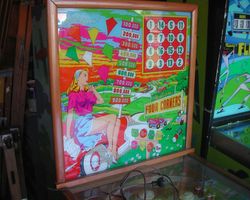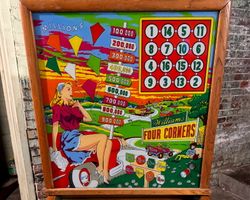Four Corners

Average Prices: USD $400 to $700
Produced: October, 1952
Machine Type: Electro-mechanical
Players: 1
Design by: Harry Williams
Art by: George Molentin
Four Corners, a distinctive electro-mechanical (EM) pinball machine, emerged from the Williams Electronic Games, Inc. production line in October 1952. This machine, model number 78, represents a curious intersection of traditional pinball mechanics and the popular game of bingo, a design philosophy spearheaded by Harry Williams himself, who is credited with the machine's overall design, concept, animation, and mechanics. George Molentin provided the artwork, visually translating the machine's travel and automobile theme.
At a time when the pinball industry was continually experimenting with new ways to engage players and broaden its appeal, Four Corners arrived with an innovative proposition: five balls for five cents. This pricing model was a deliberate strategy to offer extended playtime and increased opportunities for players to interact with the machine's unique features. The machine's production run, characterized by its standard cabinet type, suggests a confident rollout, indicative of Williams's readiness to explore new game formats that could capture a wider audience. The core idea behind Four Corners was to fuse the action of flipper pinball with the methodical pattern-matching of bingo, setting it apart from contemporary designs.
Signature Features and Design
The defining characteristic of Four Corners lies in its ingenious integration of bingo elements into a flipper pinball framework. This hybridization is visually and mechanically anchored by the machine's 16 strategically placed trap holes. These are not merely passive collection points; rather, they are integral to the primary gameplay objective, functioning as targets that illuminate corresponding numbers or positions on the backglass. The artwork, skillfully rendered by George Molentin, reinforces the machine's travel and automobile theme, inviting players on a conceptual journey across a stylized map. The "Four Corners" motif itself alludes to the geographical extremes of the United States, suggesting a cross-country adventure. The visual design subtly guides players through this journey, with lighting effects on the backglass indicating progress toward completing specific patterns, much like a bingo card. Beyond the trap holes, the machine features two flippers, two pop bumpers, and seven passive bumpers, providing a blend of traditional pinball action with the precision aiming required for its unique objectives. The "5 balls for 5 cents" mechanism, while a pricing strategy, also becomes a signature design feature, guaranteeing an extended, multi-attempt game experience that aligns well with the pattern-completion goal.
Playfield and Mechanics
The playfield of Four Corners presents a layout that balances the familiar with the novel. At its core, the two flippers are positioned at the bottom, standard for the era, allowing for ball manipulation and shot execution. Above them, two pop bumpers provide dynamic, unpredictable ricochets, while seven passive bumpers are scattered across the upper and mid-field, contributing to score accumulation and guiding the ball's trajectory. However, the true distinction of the Four Corners playfield is the pervasive presence of its 16 trap holes. These are distributed thoughtfully, often at the end of lanes or in pockets, requiring players to aim with precision to drop the ball into specific locations.
The design philosophy behind this layout is a clever fusion: players engage in traditional flipper action to propel the ball, but the ultimate goal shifts from merely keeping the ball in play or hitting high-value targets to strategically guiding it into these trap holes. Each trap hole is linked to a specific position on the backglass, which lights up upon a successful capture. This creates a dual flow – chaotic bumper action interspersed with precise, deliberate shots towards the traps. George Molentin's artwork on the playfield seamlessly integrates the travel theme, with subtle road maps, city names, or landmarks visually connecting the trap holes to the broader "Four Corners" journey. The lighting, primarily driven by the backglass, serves as the primary feedback mechanism, indicating which "corners" or patterns have been illuminated, guiding the player's progress through the unique game objective.
Gameplay Dynamics
Four Corners offers a distinct gameplay experience driven by its unique scoring system and progression mechanics. Unlike typical pinball machines where the primary goal is often to maximize a numerical score, Four Corners introduces a pattern-matching objective akin to bingo. Players aim to land the ball into the 16 trap holes scattered across the playfield. Each successful drop lights up a corresponding spot on the backglass, representing a point on an internal "bingo" grid. The core objective is to complete specific patterns, such as horizontal, vertical, or diagonal lines, or the literal "four corners" of this internal grid. Achieving these patterns awards points, extra balls, or even replays, significantly enhancing the game's depth beyond mere point accumulation.
The availability of five balls for a single credit is fundamental to the game's strategy. This multi-ball access allows players multiple attempts to hit specific trap holes and complete patterns within a single game. A common strategy involves using the flippers not just to keep the ball in play, but to precisely guide it towards unlit trap holes, prioritizing those that will complete a crucial line or pattern. The game rewards accuracy and foresight more than rapid-fire flipper skills alone, though ball control remains important to maneuver the ball into advantageous positions. The blend of conventional pinball physics with this unique pattern-matching objective provides a captivating challenge, encouraging players to think tactically about each shot.
Reception and Legacy
Four Corners, upon its release, elicited a varied response within the pinball community. Its primary strength was undoubtedly its innovative hybrid concept. The integration of bingo elements into a flipper game was a bold move, appealing to both seasoned pinball players seeking novelty and a broader audience familiar with bingo mechanics. This fusion demonstrated Williams's willingness to experiment, a characteristic that would become a hallmark of its designs. The "5 balls for 5 cents" pricing was also a significant draw, offering extended playtime and perceived value, which contributed to its initial commercial viability. The machine’s mechanical ingenuity in linking specific trap holes to backglass lights for pattern completion was noted as a testament to Harry Williams's design prowess.
However, the machine also presented certain limitations. For purists who favored complex shot-making and intricate flipper sequences, the emphasis on landing balls into static trap holes for pattern completion might have felt less dynamic than a pure skill-based pinball game. The randomness inherent in ball drops could sometimes overshadow the player's skill in achieving patterns. Despite these points, Four Corners secured a place in pinball history as a significant experimental design. Its legacy lies in showcasing how manufacturers in the electro-mechanical era were constantly pushing boundaries, attempting to blend different game genres. It paved the way for future machines that would also dabble in unique scoring systems or objective-based gameplay beyond simple point accumulation, demonstrating Williams's forward-thinking approach to game design and its influence on the evolving landscape of pinball.
Sponsored Links
 Ebay Listings
Ebay Listings
 Auction Results
Auction Results
| Cost | Location | Date |
|---|---|---|
| USD $750 |  Ohio, United States Ohio, United States |
12 September, 2024 |
| USD $300 |  Pennsylvania, United States Pennsylvania, United States |
02 May, 2016 |


Private Policy · Search Website · Contact Us
As an eBay Partner, we may earn a commission from qualifying purchases made through links on this site, at no additional cost to you.
All trademarks and copyrighted materials remain property of their respective owners. All other content copyright 2007 - 2026 Pinpedia.


